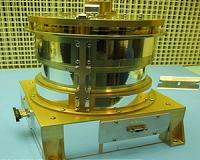 |
Oberpfaffenhofen, Germany (SPX) Mar 17, 2011 On 15 March 2011, the German Space Operations Center (GSOC) at the German Aerospace Center in Oberpfaffenhofen took over operation of the Swedish PRISMA satellite mission. The Swedish Space Corporation (SSC) implemented the transfer of control as part of a bilateral agreement. DLR will be responsible for mission operations for a period of five months and has the opportunity to carry out additional experiments. The PRISMA mission was launched on 15 June 2010 and consists of two satellites, Mango and Tango. The aims of the mission are the demonstration of autonomous satellite formation flying and preparation for future inspection and repair missions in orbit.
Operational tasks The network of ground stations consists of the DLR antennas at Weilheim and the antennas operated by SSC in Sweden. Ten times a day, the two PRISMA satellites, Mango and Tango, transmit signals to the receiving stations and receive new commands from Oberpfaffenhofen. Three teams work there in shifts, looking after the flight control systems. GSOC will be drawing on its experience with numerous national and international satellite missions as it takes over operations for the next few months. Specific preparation for this task took place at the SSC Operations Center in Stockholm. Even so, operating PRISMA will be a particular challenge for all those involved. According to Faller, this is because: "PRISMA is the first European satellite mission to demonstrate autonomous formation flying at distances between 30 kilometres and two metres."
Autonomous formation flying For autonomous formation flying, the satellite needs information concerning its own position and speed in relation to the other object. Extremely precise determination of the position and relative movement of the satellites is carried out using an innovative GPS receiver developed by DLR. The systems for onboard calculation of orbital manoeuvres and control of the satellites were developed by SSC and are based on special algorithms. These systems allow Mango to 'know' precisely when it has to fire its thrusters and when to shut them down again in order to implement the required flight formation.
Plans and objectives So, as well as taking control of operations, GSOC is also carrying out research tasks in the form of the mission-related SAFE (Spaceborne Autonomous Formation-flying Experiment) and AOK (Autonomous Orbit Keeping) experiments prepared by DLR. SAFE is used to test out autonomous satellite formation flying, whereas AOK explores orbit control of a single spacecraft. After handing back control of the mission in the summer of 2011, cooperation with the SSC on additional experiments on board the PRISMA satellites is planned. Uses to which the DLR will put the knowledge and experience it gains include preparation for the German Orbital Servicing Mission (Deutsche Orbitale Servicing Mission; DEOS) planned for 2015, which is intended to demonstrate the capture and controlled disposal of obsolete satellites.
Share This Article With Planet Earth
Related Links PRISMA mission Swedish Space Corporation (SSC) Space Technology News - Applications and Research
 FASTSAT Mission Update
FASTSAT Mission UpdateGreenbelt MD (SPX) Mar 14, 2011 To date, the MINI-ME instrument has acquired more than 29 days of observations at optimal science level (i.e., running with the power inputs and other characteristics to which it was initially calibrated in the lab). The instrument has flown during periods of magnetic activity and observed neutral atoms over a wide range of geomagnetic levels. MINI-ME will provide measurements of neu ... read more |
|
| The content herein, unless otherwise known to be public domain, are Copyright 1995-2010 - SpaceDaily. AFP and UPI Wire Stories are copyright Agence France-Presse and United Press International. ESA Portal Reports are copyright European Space Agency. All NASA sourced material is public domain. Additional copyrights may apply in whole or part to other bona fide parties. Advertising does not imply endorsement,agreement or approval of any opinions, statements or information provided by SpaceDaily on any Web page published or hosted by SpaceDaily. Privacy Statement |